The Thar Desert, spread over 2.3 million sq.km., the only ecosystem of its type in the Indian subcontinent, is represented by Desert National Park. 85% of the Thar Desert is in India and the remaining is in Pakistan’s Sindh and Punjab provinces. In India, it spreads over 2. million sq. km in Rajasthan, Punjab, Haryana, and the Rann of Kutch in Gujarat.
The Desert National Park is situated within the Thar Desert in the Jaisalmer and Barmer districts of Rajasthan, India. It was notified as a Wildlife Sanctuary with an area of 3,162 sq. km in 1980, vide the Govt. of Rajasthan notification no. F3(1)73/Rev./ Group-8/dated 04.08.1980. Of this, 1,900 sq. km area falls in Jaisalmer district and the remaining 1,262 sq. km area falls in Barmer district.
In 1981, the Desert Wildlife Sanctuary was notified as Desert National Park by the Govt. of Rajasthan vide notification dated 08.05.1981, to protect the habitat of large ground-feeding birds, mainly the Great Indian Bustard (GIB) and two Gyps vulture species. This notification covered the same area of 3,162 sq. km that had been notified as a sanctuary on 04.08.1980, under Section 35 (1) of the Wildlife Protection Act, 1972.
Since the Thar Desert is often called an ‘ocean of sand,’ the park is in an extremely hot, arid region with very low rainfall. The human population within the park is low, at 4-5 persons per square kilometer.
The main tourist destinations in Desert National Park are the Patwon Ki Haveli, Sonar Kila, Kuldhara, Bada Bagh, Gadisar Lake, the Sam sand dunes, and Khuri sand dunes, which are popular for camel safaris and cultural programs. The Jaisalmer War Museum and the Akal Wood Fossil Park are also attractive visiting places.
Desert National Park Location, Ranges, Villages, and Boundary
1. Location:
Desert National Park is located near the border area of Pakistan and India, in the districts of Jaisalmer and Barmer in Rajasthan. The geographical coordinates of the park are 25°46’ to 26°47’ North latitude and 70°15’ to 70°45’ East longitude. The average height in this area differs from 210 to 300 meters, with the maximum reaching up to 320 meters above sea level.
The park is about 120 km from the international boundary of India and Pakistan towards the western side. The nearest Railway Station to Desert National Park is Jaisalmer located 50 km away and the nearest airport is in Jodhpur approximately 300 km away. Barmer, the neighboring district headquarters where 1,262 sq. km of the park is located, is approximately 150 km away from Jaisalmer.
2. Ranges:
The Thar Desert is so vast that a range has been set up in Pokran to take better care of the wildlife. This satellite area of Desert National Park includes Pokran, Loharki, Dudsar, Ramdeora, and the surrounding landscape. Desert National Park is divided into four ranges: Jaisalmer, Barmer, Miajlar, and the Pokran satellite range. Only 50.76 sq. km. is the forest area within DNP that falls in two categories viz. Protected Forest and Un-classed Forest.
Initially, from 1980 to 1986, the Desert National Park was managed by the Director of Desert Afforestation & Pasture Development, Jodhpur, focusing on pasture development under the Desert Development Programme. Since 1986, it has been under the Wildlife Wing of the Forest Department, with planned development starting under the Five-Year Working Plan Project.
3. Villages:
Desert National Park is spread over 3162sq.km which is 1900 sq. km. falls in Jaisalmer district and 1262 sq. km. in Barmer district. There are 88 villages inside and outside the Desert National Park and about 64 villages located within a 10 km periphery of the park boundary. In the Jaisalmer area, there are 35 villages out of which 14 villages are situated entirely inside the park and 21 villages are partially inside. In the Barmer area of the park, there are 53 villages out of which 31 villages are situated entirely inside the park and 22 villages are partially inside.
As per the 2011 census, it is around 38696 total human population residing inside the park and the cattle population is about 3,32,750.
The Thar Desert is the most densely populated globally, with 83 people per km², compared to 7 per km² in other deserts. However, within the Desert National Park, the human population density is much lower, at 4-5 people per km².
There are segregated areas for different castes within the village and the village society is divided based on caste-lines. The dominant caste groups are Rajput and Muslim, but there are also sizeable populations of Meghwal, Charan, Manganiyar, Bhil, Jogi, Jat, Sansi, Sonar, Banjara, Nai, Baba, Kumhar, Sonar, Banjara, and Brahmin. The family’s society is male-dominated.
The primary occupation of the villagers inside the Desert National Park is animal husbandry like goat, sheep, cattle, camel, donkey and followed by agriculture.
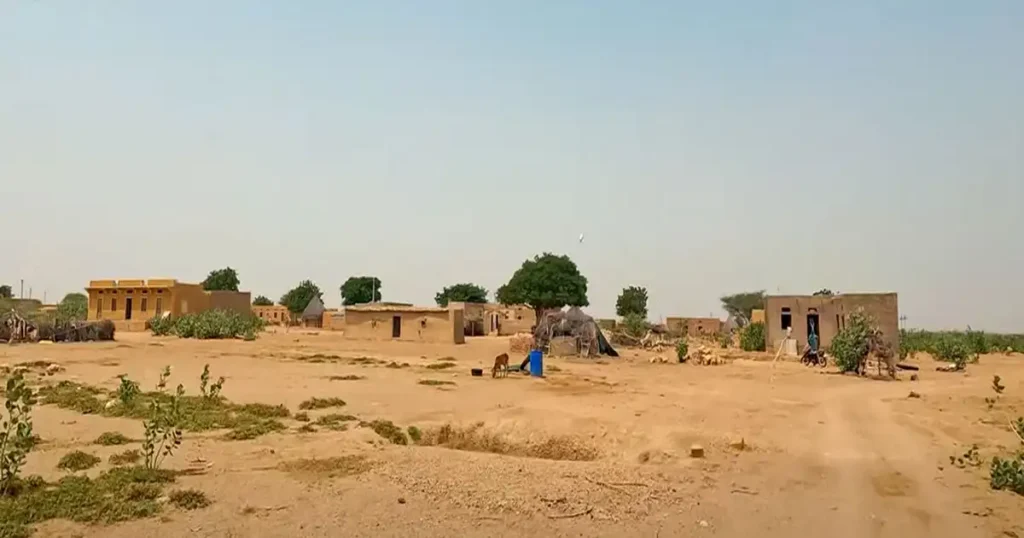
4. Boundary:
A large part of Desert National Park falls in Jaisalmer district. The Boundary Description of Desert National Park is as follows:
a. Northern Boundary:
The city of Jaisalmer is about 30 km north of the Desert National Park boundary. This boundary incorporates Jaisalmer Stone No. 34 on the Jaisalmer-Dhanana Road, extending to Sam along the same road.
b. Western Boundary:
The western boundary of Desert National Park starts from Sam along the Sam-Lunar Track and passes through Meghwalon Ki Dabri, Dabri Village, Satani Village, Koria Village, Hatar Village, Daw Village, and Miajlar Village. It also passes through Sundara village and ends at the boundary between Sundara and Jaisindhar villages. On the west beyond the sanctuary boundary lies the international boundary with Pakistan.
c. Southern Boundary:
The southern boundary of Desert National Park starts from the junction of the northeast boundary of Sundara village and runs along the boundaries of the following villages: Jaisindhar, Medusar, and Harsani in the Barmer district. Then, it follows the village paths and boundaries and includes/excludes certain areas, demarcated by several corner points and boundary pillars, ending at a point on Shiv Gadra Road.
d. Eastern Boundary:
The eastern boundary of Desert National Park starts at K.M. stone No. 68 on Shiv Gadra Road and heads northwards through Harsani and Turvi villages. Further, it continues along the tracks to Khijar Ropar, Girab, Agasari, and Asadi, moving northwards. It proceeds north to Sidar in Jaisalmer district, via Antiya, Banbhara, and Kahria villages. Along the tracks to Khuri via Nakhtor-ki-Dhani and Naharsingh Ki-Dhani, and then to K.M. Stone No. 35 on Jaisalmer-Miajlar Road. The boundary terminates at Kumher-Kotha, Jamra, and Kanoi.
Desert National Park Map
The following is a map of the Desert National Park, including several features such as the boundary of the park itself, the surrounding villages’ boundaries, district roads, and the paved roads running through it. All these are well-marked to assist visitors in navigation and make sense of the structure of the park and its surrounding areas.

History Desert National Park
- In the late 1970s, the Government of India began searching for an area with the defining characteristics of a desert and minimal human population pressure. The goal was to allow wildlife to flourish and protect a representative desert ecosystem and its wildlife.
- In 1976, the National Commission on Agriculture advocated setting up a biosphere reserve in the desert area that aimed to maintain the desert ecosystem in its natural state for future generations.
- In 1979 Shah Badar of Iraq came to India for hunting along with trained falcons and other hunting equipment.
- Local people widely opposed this action because Shah Badar of Iraq hunted the Godavan (Great Indian Bustard), Tillor (Houbara Bustard), and other wildlife.
Finding a suitable and large area in the densely populated Thar Desert wasn’t easy. Moreover, various geopolitical, economic, social, and defense factors had to be considered before an area could be designated as a Protected Area (PA). The main considerations were as follows:
- The area should be located away from the Indira Gandhi Nahar Project (IGNP) command area.
- It should be distant from the international boundary.
- It shouldn’t fall within the military exercise zone.
- The human population should be very low to minimize the impact on people and livestock.
- The area should encompass all the characteristics of the Thar Desert and have the potential to support growing wildlife populations.
- After many years of deliberations, a large area of about 3,162 sq. Km. in the district of Jaisalmer and Barmer was selected and notified as a Desert Wildlife Sanctuary in 1980, as per Government of Rajasthan notification no. F3(1)73/Rev./Group-8/dated 04.08.1980.
- On 08th May 1981, it was notified as Desert National Park by the Govt. of Rajasthan vide notification to protect the habitat of large ground-feeding birds, mainly the Great Indian Bustard (GIB) and two vulture species.
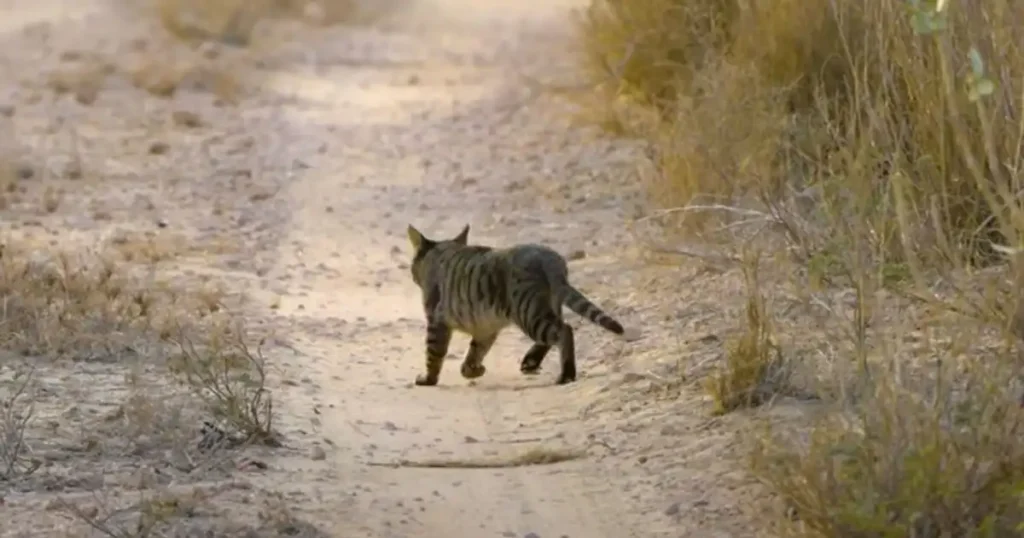
Geography, Soil, Terrain, Climate, and Water
1. Geography:
Desert National Park (DNP) in the Jaisalmer region has a fascinating geological history. This portion was under sea during the Jurassic and Cretaceous periods and was probably uplifted in the Upper Tertiary period. This upliftment changed the courses of the rivers Saraswati and Dhrishtavati. By the late Pleistocene, after the last glaciation phase, the region had become arid.
Exposures of fossilized wood logs of the Jurassic age are found in the rolling topography of the Akal Wood Fossil Park. Small outcrops of Jurassic rocks, comprising limestone, sandstone, and shale, occur within the desert sand and alluvium.
Desert National Park is located in the Thar Desert, which is a confluence of many geographical regions like Cosmopolitan, Tropical African, Rajasthan, endemic oriental, Indo-Malayan, and Indo-Chinese. Some areas remain untouched and undisturbed due to lack of water, which helped to preserve the desert environment.
The desert is older than human colonization. Carbonate pans demonstrate that arid conditions started much earlier than a few thousand years ago. Probably, thick layers of sand were formed during the Quaternary or even earlier. Unlike the common belief, much of the sand was due to inland erosion rather than coastal winds, which is a very long process to form these enormous stretches of sand in DNP.
2. Soil:
The Thar Desert can be regarded as a transition zone between major wind belts. Landforms are typical of level to gently sloping plains, with an abundance of dunes and low, bare hills. Surface materials in the Thar Desert consist of mixes of sandy, medium, and fine-textured materials. Gravelly soils occur mainly only on the “magra” lands.
3. Terrain:
The terrain of Desert National Park is largely sandy, with shifting, semi-stabilized, and stabilized dunes, with fertile inter-dunal flatlands. Gravelly lands, rocky hills, and plateaus, locally known as “Magra,” occur in small patches and are confined mostly to the northern part, with some outcrops occurring in the central region. The southern one-third of the sanctuary consists of upland sandy, undulating plains between Girab and Turvi in the southeast and near Satto in the northwest. The central part is also characterized by sandy uplands with patches of undulating plains and rocky outcrops between Hatar and Aantia villages.
As a whole, the sanctuary is characterized by southern and northwest sloping aspects of the land surface.
4. Climate:
The climate in the region is at the extreme end. Summers get too hot, with temperatures rising to 49°C, and sometimes even surface temperature reaches 50°C. At night, it gets cool and the temperatures go down. Winters’ temperatures go down to even 2°C, with very strong and very high winds. Annual rainfall is 100-150mm. Winters get very cold; summers get scorching. On January 12, 1967, Jaisalmer recorded its lowest minimum temperature, reaching -5.9°C.
5. Water Sources:
There are no perennial rivers or ponds within the Desert National Park. The rainwater gets collected in low-lying areas, called ‘Khadeens’ and ‘Nadis,’ during the rainy season. These water sources are utilized for cultivation and drinking purposes.
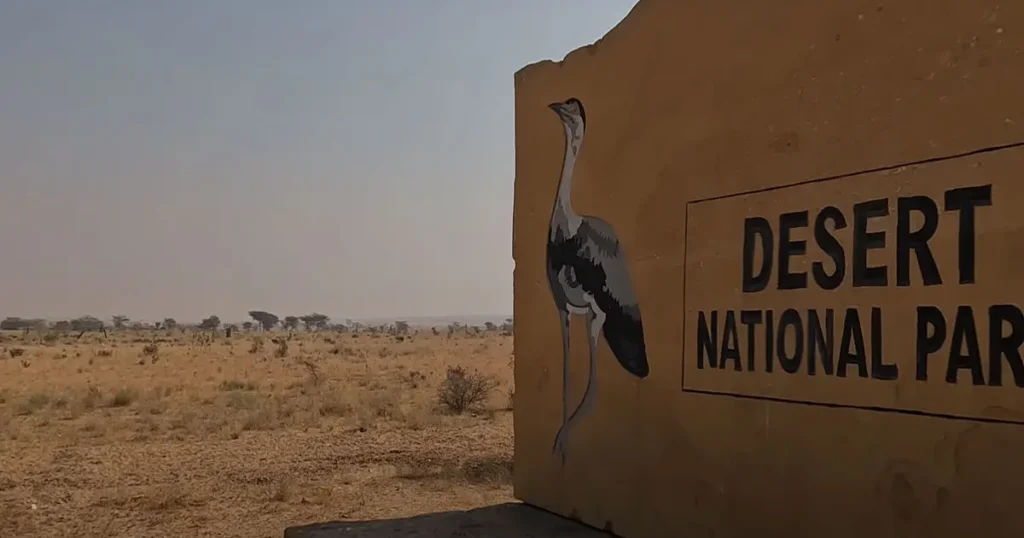
Desert National Park Bio-diversity
1. Flora
The Biogeographic Classification of India puts the Desert National Park of Jaisalmer under the desert biome. It falls under 3A Biotic Province, the Thar Desert. Vegetation is very open and species-poor, differing in composition in different habitats.
Vegetation Types in DNP:
a) Rocky and Hilly Habitats:
These are found in the northern part of Desert National Park, characterized by mixed xerophytic thorn forests. Key plants include:
- Trees and Shrubs: Euphorbia caducifolia, Capparis decidua, Grewia tenax, Acacia senegal, Salvadora persica, Maytenus emarginata.
- Climbers: Cocculus pendulus, Ephedra foliata, Rhynchosia minima, Asparagus racemosus, Coccinia grandis.
- Ground Flora: Oropetium thomeum, Enneapogon brackystachya, Tephrosia uniflora, Lepidagathis bhanadaraensis, Barleria acanthoides.
b) Flat Terrains with Rock Fragments:
The vegetation includes:
- Trees: Acacia senegal, Ziziphus nummularia, Lycium barbarum.
- Shrubs: Capparis decidua, Leptadenia pyrotechnica, Boerhavia diffusa, Heliotropium strigosum, Salvia aegyptica, Indigofera trigonelloides.
c) Alluvial Plains:
Dominated by mixed xeromorphic wooded desert vegetation:
- Trees: Prosopis cineraria, Salvadora oleoides, Tecomella undulata.
- Common Associates: Calotropis procera, Mimosa hamata, Acacia jacquemontii, Haloxylon salicornicum, Crotalaria burhia, Lasiurus sindicus, Cenchrus biflorus, Cyperus rotundus, Indigofera cordifolia, Aerva persica.
d) Sand Dunes:
Vegetation primarily consists of:
- Plants: Calligonum polygonoides, Lasiurus sindicus, Panicum turgidum, Cenchrus biflorus.
e) General Flora:
According to secondary data, Desert National Park hosts about 168 vascular plant species across 111 genera and 45 families. Common plants include:
- Shrubs, Herbs, and Grasses: Lasiurus sindicus (Sewan), Calligonum polygonoides (Phog), Cenchrus biflorus (Bhurut), Dicanthium annulatum (Karad), Sporobolus marginatus (Sinia), Indigofera cordifolia (Bekar), Desmostachya bipinnata (Dab), Panicum turgidum (Moorut). Haloxylon salicornicum (Lana), Mimosa hamata (Jhinjhnia).
The vegetation largely consists of stunted, thorny, or prickly shrubs and perennial herbs adapted to drought conditions.
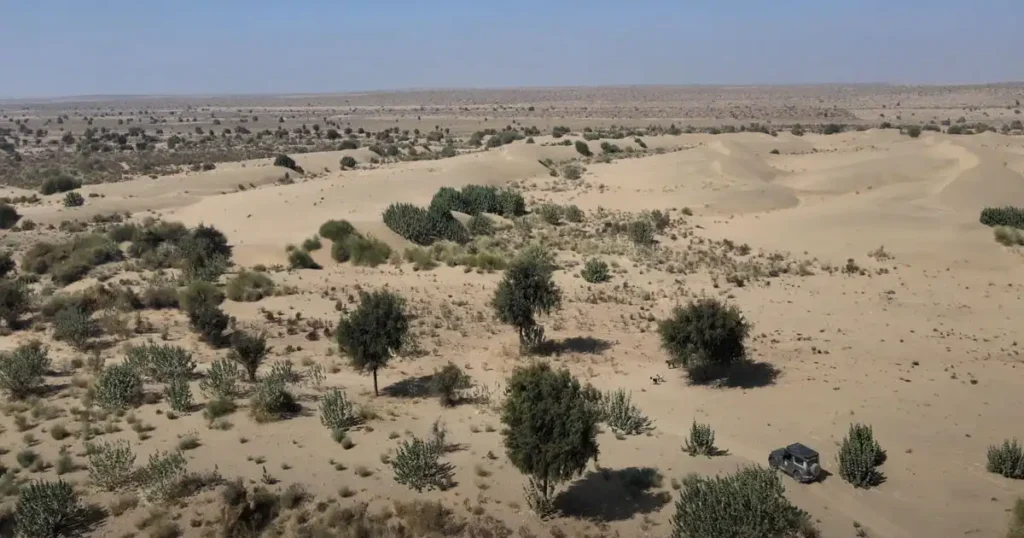
2. Fauna
i) Mammals:
According to the DNP manual, approximately 21 species of mammals inhabit the park. Among the large mammals, Chinkara or Indian Gazelle (Gazella bennettii) is the most common large mammal.
Other rare species are the Long-Eared Hedgehog, Desert Fox, Pale Hedgehog, Indian Fox (Vulpes bengalensis), Desert Hare, Small Indian Mongoose, Balochistan’s Gerbil, black-naped hare, Desert Cat, Hairy-Footed Gerbil, Indian Desert Gerbil (Meriones hurrianae), and the sand-colored rat (Millardia gleadowi).
ii) Avifauna:
The Desert National Park is famous for the Great Indian Bustard (GIB) (Ardeotis nigriceps) locally called Godawan, which is the state bird of Rajasthan. One of the main purposes for establishing Desert National Park was to protect the GIB and two species of Gyps vultures, which are still found in the park but remain under threat. The Great Indian Bustard is now “Critically Endangered” according to the IUCN Red List (2017-1) and is listed under Schedule I of the IWPA (1972). As per the Dy. Conservator of Forest, Desert National Park office, the population of Great Indian Bustard is nearly 200 in number.
The Pokran Field Firing Range (PFFR) covers 5,000 sq. km. from Pokran to Jaisalmer, spanning 80-100 km in length and 60-80 km in width. With no villages inside and only peripheral habitation within 3-5 km, it offers an inviolate habitat for the Great Indian Bustard (GIB). Over 60% of the wild GIB population is estimated to reside in the PFFR.
The park is also home to about 107 species of birds, including the largest population of the Great Indian Bustard in the world. Macqueen’s Bustard, a migratory bird, visits the DNP in the winter season from Central Asia via Pakistan. Other bird species reported in the DNP area include Eagles, Vultures, Bee-Eaters, Shrikes, Larks, Demoiselle Cranes, Sand Grouse, Honey Buzzards, Chats, Babblers, Kites, and more.
A study by Mukherjee (1995) reported about 47 endemic, 118 resident, and 157 migratory bird species in the area. GIB bird has been recently put in the category of ‘Critically Endangered’ by IUCN.
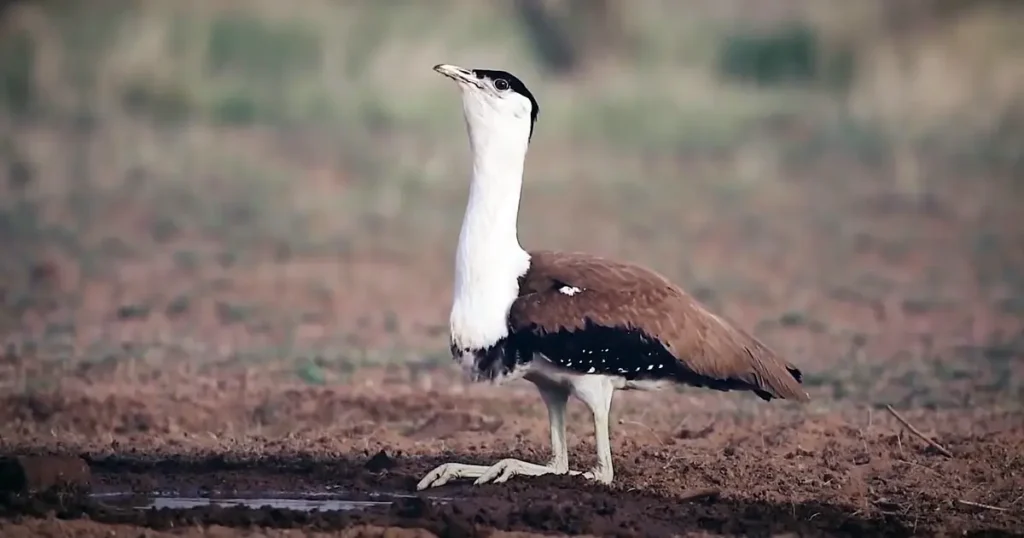
iii) Reptiles:
The Desert National Park boasts a rich diversity of reptiles, including 11 species of lizards and 4 species of snakes. Out of 456 species of reptiles from India, 40 species are found in the Thar Desert. The most unique among them is the Jaisalmer toad agama (Bufoniceps laungwalensis), which is endemic to this desert. This diurnal species inhabits loose dunes.
The lizard species include the Keeled Rock Gecko, Sindh Sand Gecko, Garden Lizard, Brilliant Agama, Jaisalmer Toad Agama, Spiny-Tailed Lizard, Indian Sand Fish, Indian Fringe-Toed Lizard, Punjab Snake-Eyed Lacerta, Indian Monitor (Varanus), and Desert Monitor.
The snakes recorded in the DNP are the Sand Boa, Saw-Scaled Viper, Sand Snake, and Red-Spotted Royal Snake.
iv) Amphibians:
Due to the absence of seasonal and perennial rivers, the only water bodies in the Desert National Park are small ponds that fill with water during the rainy season and dry up 2 to 3 months after the monsoon. The amphibian species reported in the DNP are the toad (Bufo stomaticus) and the frog (Euphlyctis cyanophlyctis).
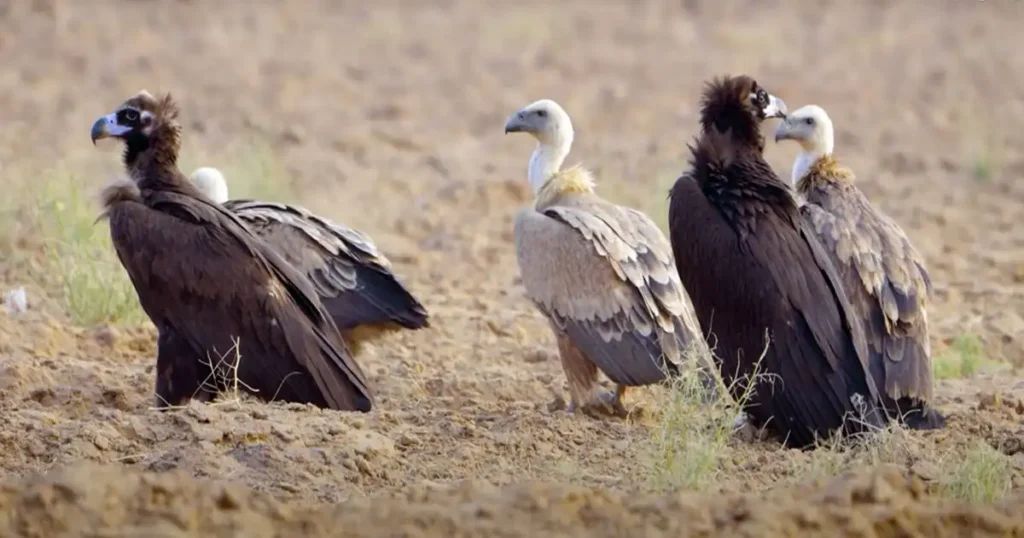
Places to visit in Desert National Park
The main tourist destinations in Desert National Park are the Patwon Ki Haveli, Sonar Kila, Kuldhara, Bada Bagh, Gadisar Lake, the Sam sand dunes, and Khuri sand dunes, which are popular for camel safaris and cultural programs. The Jaisalmer War Museum and the Akal Wood Fossil Park are also attractive visiting places.
The following destinations are key areas of tourism value and are accessible to general tourists:
- Khuri — Known for its potential for camel safaris, desert safaris, and sand dune trekking.
- Sam — Offers camel safaris, a desert cultural center, desert safaris, a cafeteria, a souvenir shop, and an interpretation center.
- Sudasari — Offers camel cart wildlife safaris, observation towers, hide photography, and vehicle safaris along the outer peripheral roads of the closures.
- Gajaimata — Offers sand dune trekking, camel safaris, and a sunset viewing point
- Kanoi — Offers desert safaris and camel safaris.
1. Khuri
Khuri is a village located in the Desert National Park and is covered with long stretches of golden sand dunes, thus making it a perfect retreat for offbeat experiences in the desert. It is approximately 50 kilometers from Jaisalmer.
This village has enough decent spots to stay, ranging from desert resorts and campsites to lodges and guest houses, hence accommodating all kinds of travelers. You can relish authentic Rajasthani food and enjoy folk programs in the form of dances, music, and bonfires. It is an ideal place to have a memorable holiday amidst nature.
The village of Khuri dates back more than 400 years when it was ruled by Rajputs. It has now grown to include about 100 traditional homes where the villagers still live in their clay-and-dung huts, living their lives by independent trajectories and making a valuable contribution to eco-tourism in this arid region.
Here, one can find solace and experience the village life of rustic Rajasthan. The wildlife that roams this area, comprising Great Indian Bustards, Desert Foxes, Mongooses, Nilgai, Peacocks, and Chinkaras, can easily be spotted.
2. Sam Sand Dunes:
Located 40 kilometers from Jaisalmer amidst the Thar Desert, Sam Sand Dunes is a popular tourist spot. The beautiful dunes are hills or ridges of sand formed by wind or water, rising 30 to 60 meters high, providing a glimpse into traditional Rajasthani village life with a range of fun activities. Dunes are shaped by the movement of sand and can vary in size and shape, creating distinctive and often picturesque landscapes.
Colorful tent resorts and lively, carnival-like celebrations add to the charm of this breathtaking stretch of dunes. Many tourists come to enjoy the beautiful sunrise and sunset views at Sam Sand Dunes.
Here, you can go on a desert safari, take a camel ride, try dune bashing, camp out, enjoy bonfires, and watch folk dances and music. Spend the night singing, dancing with other travelers, or stargazing under the clear desert sky.
Entry Fees and Timing-
Sam Sand Dunes Camp Kanoi is open year-round, and winter is the best time to visit due to the pleasant weather. The campsite charges a reasonable fee that includes accommodation, meals, and activities, varying based on the tent type and stay duration.
There is no entry fee, but camel safaris cost ₹20-200, and jeep safaris ₹500-1500.
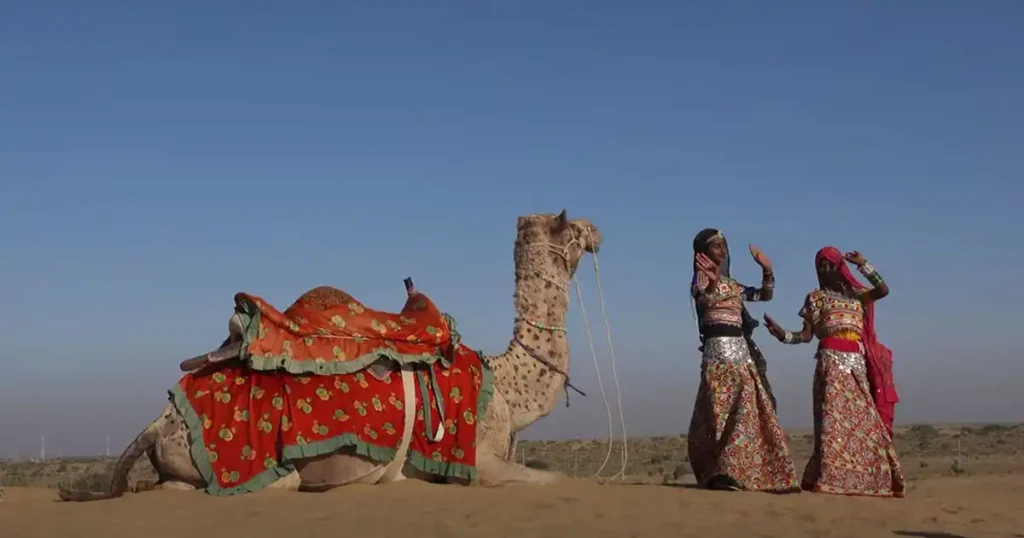
3. Akal Wood Fossil Park
Akal Wood Fossil Park is one of the largest National Geological Monuments and Biodiversity Heritage Sites located in the Jaisalmer district of Rajasthan. It is around 21 hectares located in Akal village, about 17-18 km southeast of Jaisalmer, 1 km off NH-68 Jaisalmer-Barmer road. It is a bare rocky park forming a part of the Jaisalmer’s fossil belt, which is an enormous underground reserve. Fossils and pterosaur footprints have been found nearby.
The park features Early Jurassic fossils, including Pterophyllum, Equisetites species, Ptilophyllum, dicotyledonous wood, and gastropod shells. There are about 25 petrified tree trunks, with the largest being 13.4 m long and 0.9 m wide, dating back 180 million years.
Declared a National Geological Monument by the Geological Survey of India (GSI) in 1972, the park was maintained by GSI until 1985 when the Forest Department of Rajasthan took over. Now, the Desert National Park authorities maintain it, protecting exposed tree trunks with iron grill cages and tin sheet roofing.
The fossils are from non-flowering trees like Chir, Redwood, and Deodar, indicating lush forests in a tropical, humid climate 180 million years ago. Gastropod shells suggest the area was once a sea. Fossils show the region has been submerged four times, though the host rocks are continental.
Buried tree trunks were brought to the surface by geological activities. Additional wood fossils and evidence of fruits lie beneath the surface.
The nearest, the Habur Formation, in the vicinity of Harbur village, has also produced remains of large predatory sharks from the early Cretaceous period, such as Cretalamna, Dwardius, Leptostyrax, Squalicorax, and Eostriatolamia, dating back 115 million years.
The park is open from 9 a.m. to 6 p.m. and there is a nominal entrance fee. There is a small museum at the entrance with photographs and descriptions of fossils.
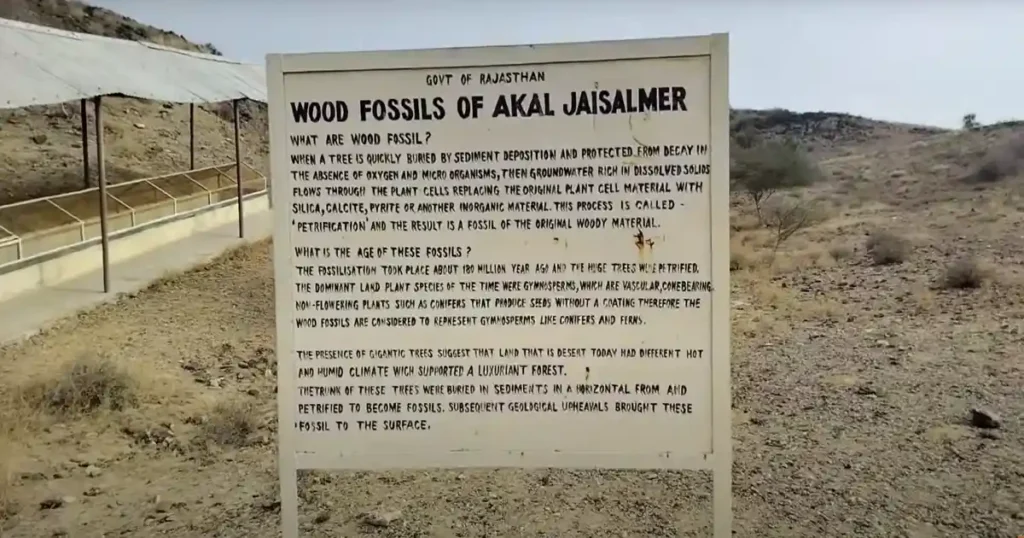
4. Khaba Fort, Jaisalmer:
The Khaba Fort is located in the Desert National Park, some 20 km away from the city of Jaisalmer in the Thar Desert of Rajasthan. This ancient fort, dating back to the 14th century, represents its history and culture. It has been since the 1800s a deserted fort that contained shops, houses, and temples. The houses and shops are long gone, but these temples are still beautifully preserved and display the tales of various Hindu gods and goddesses in their intricate carvings.
History:
The Fort of Khaba was built by the affluent and rich Paliwal Brahmins, who transformed it into a stronghold on defense with its self-contained community. It had an absolutely worked-out water management system with all arrangements for storing and preserving water. It was abandoned in the 19th century due to a severe drought and, as it stands today, testifies to the ingenuity and resiliency of its builders.
Architecture and Layout:
This magnificent fort, built with sandstone in the characteristic yellowish-brown color of Rajasthani architecture, is with a temple, a palace, and a chain of rooms and courtyards. Specially designed underground chambers used as storage places and a refuge during wars show the genius of the Paliwal Brahmins.
Information for Visitors:
Location: It lies within the Desert National Park, about 20 km from the city of Jaisalmer.
Timings: 9 am to 6 pm daily
Entry Fees: Rs 50 Indian, Rs 100 Foreign
Tips: Comfortable shoes and clothing as it is rocky
How to Reach Khaba Fort:
Khaba Fort is well connected by local transportation such as taxis, auto-rickshaws and rented vehicles from Jaisalmer.
Scenic Spots:
One is only left to imagine the awe as visitors wind down alleys and narrow streets of the deserted city that lead to different temples. More especially, the fort evokes breathtaking views during sunset with the setting sun washing it with its warm glow, making it an ideal spot for picture capturing.
With a haunting reminder of a time past, yet standing proud enough to show nature’s mighty power, Khaba Fort proffers an unforgettable experience to all who visit.
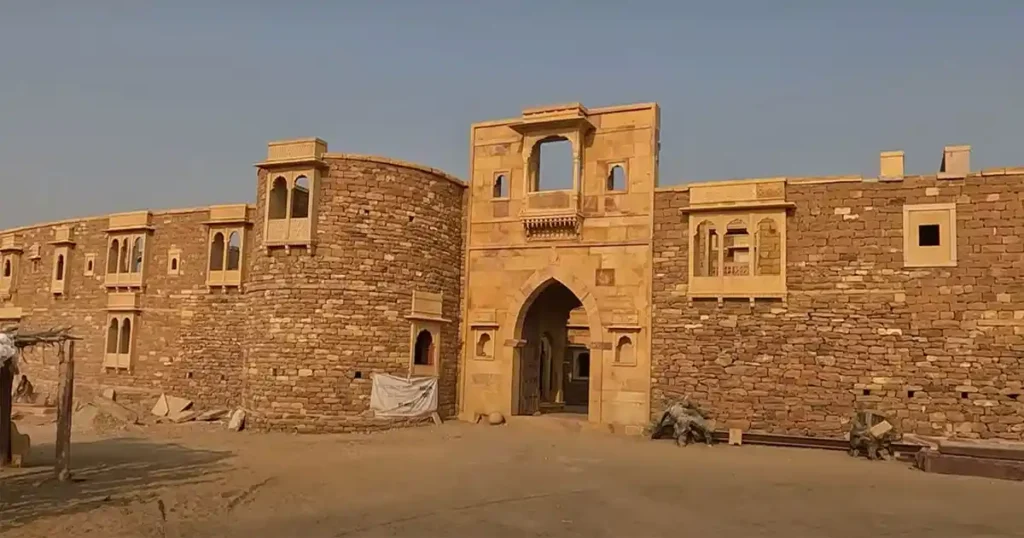
Best Time to Visit Desert National Park
The best period to visit the park is during the winter months, from October to March when the climate is most pleasant, and you can witness migratory birds. Entry permits are needed, and it’s suggested to check with the local authorities for the latest information, rules, and regulations.
Be sure to respect the fragile desert ecosystem and follow conservation guidelines during your visit to Desert National Park.
1.Winter (November to March):
Winter is the best time to visit the Desert National Park. These months are very pleasant, with temperatures ranging from 10°C to 25°C, and the days are ideal for a visit. The nights are chilling, and it often goes below freezing in December and January. This is the time that one can enjoy the beauty of the park without getting into the extreme scorching heat. Winter is the peak tourist season and also the time to enjoy festivals and cultural activities at their best.
Visitor Activities:
- Jeep Safaris: To explore the park Jeep safaris are a popular way and for a better understanding of the desert ecosystem it’s advisable to hire local guides. The cooler weather makes it ideal for jeep safaris to spot the Great Indian Bustard, eagles, falcons, and other wildlife.
- Camping: Enjoying a night under the clear desert sky with traditional Rajasthani music and dance is a must-do.
- Photography: The clear skies and soft winter light provide excellent opportunities for photography, capturing stunning landscapes and wildlife.
2. Off-Season, (April to October):
The climatic conditions during the summer months are sometimes unbearable. From mid-March to the end of June, it soars to more than 45°C (113°F), and the peak summer days may reach 49°C (120°F). The scorching conditions, therefore, make it hard, sometimes even hazardous, to stay outdoors. Nights are relatively cool due to the dry air of the desert, which decreases heat quickly.
3. Monsoon, (July to August):
The monsoon season brings some respite from the scorching heat, as the area receives most of its yearly rainfall during these two months. The rain, however, does come in very strong and unpredictable spurts. Dust storms and thunderstorms are common and, with high humidity, might somewhat diminish the fun of traveling around and exploring the area.
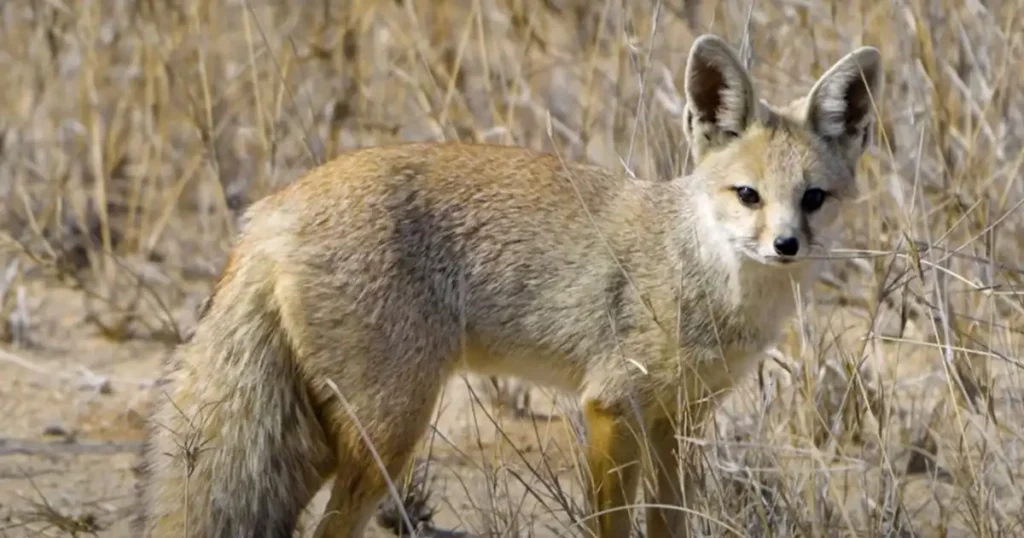
How to reach Desert National Park
Desert National Park is well-connected by air, rail, and road with Jaisalmer, also known as “The Golden City,” which is located 575 km west of Jaipur, the state capital of Rajasthan.
1. By Air:
The nearest airport is Jaisalmer Airport, which is a domestic airport situated 12.6 km away from the city center and approximately 60.7 km from Desert National Park. It is a civil enclave on an Indian Air Force base.
2. By Train:
The nearest railway station is Jaisalmer and it is 48.5 km away from Desert National Park. Jaisalmer railway station, a key station in Jaisalmer, Rajasthan, is managed by the North Western Railway. It has three platforms and five tracks. The Jodhpur-Jaisalmer Railway was merged with the Western Railway in November 1951, and the North Western Railway was established on October 1, 2002.
3. By Road:
The Desert National Park is located at a distance of 48.5 km from Jaisalmer, and it takes about 57 minutes to reach via Sam-Dhanana Road. Barmer, the district headquarters nearby, from Jaisalmer, is 150 km, and by car, it takes approximately 2 hours 34 minutes. Further from Barmer, the Desert National Park is 203 km away and by car, it takes approximately 3 hours 33 minutes to reach.
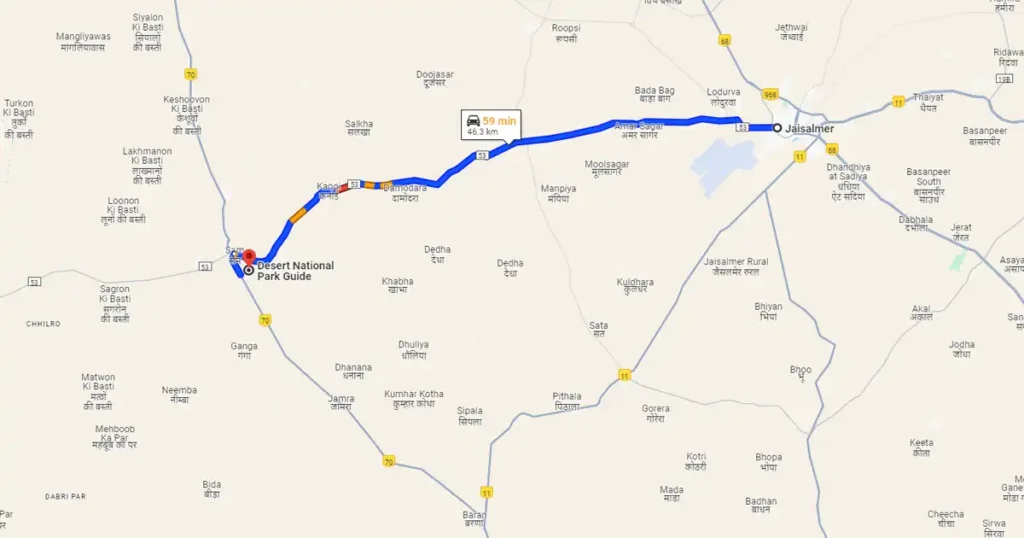
Where to Stay in Desert National Park
There are various accommodation facilities including resorts, hotels, and guesthouses within Desert National Park.
Khuri Village, 50 km from Jaisalmer, is ideal for an offbeat desert experience with desert resorts, campsites, lodges, and guesthouses. Enjoy Rajasthani food, folk dances, and wildlife spotting.
Sam Sand Dunes in Kanoi, 40 km from Jaisalmer, features dunes 30-60 meters high. Activities include desert safaris, camel rides, dune bashing, camping, bonfires, and folk performances.
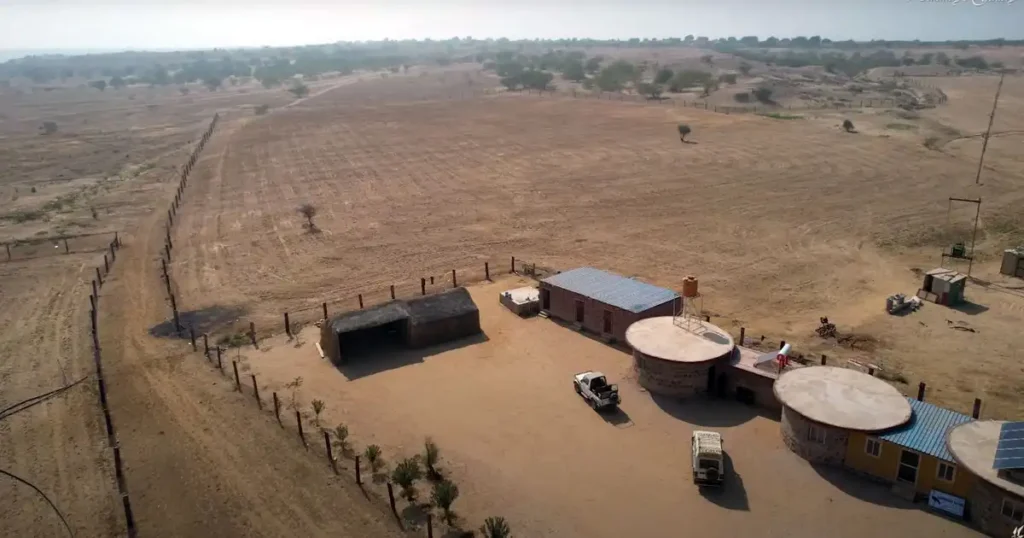
Conclusion
Desert National Park, located in the Thar Desert and spanning 3,162 sq. km, has natural features such as extensive dunes, rocky terrain, and compact Salt Lake bottoms, creating a distinctive desert landscape. The park is home to a variety of desert-adapted flora and fauna, including the endangered GIB, blackbucks, desert foxes, and various reptiles. The best time to visit Desert National Park is from October to March. During these months, the weather is more favorable, and you can witness migratory birds.
The popular way to explore the park is by Jeep safari, and it is better to hire local guides for a better understanding of the desert biodiversity.
FAQs
Q: Why is Desert National Park famous?
A: Desert National Park is famous for representing the Thar Desert, which spans 2.3 million sq. km and is the only ecosystem of its type in the Indian subcontinent. The park is also known for the Great Indian Bustard (GIB), Ardeotis nigriceps, locally called Godawan, which is the state bird of Rajasthan.
Q: Desert National Park is famous for which animal?
A: Desert National Park is famous for the Great Indian Bustard (GIB), Ardeotis nigriceps, locally known as Godawan, which is the state bird of Rajasthan. The park is also home to around 107 species of birds, including the largest population of the Great Indian Bustard in the world.
Q: Which river flows through Desert National Park?
A: The Luni is the largest river in the Thar Desert, originating in the Pushkar Valley of the Aravalli Range near Ajmer. It flows through the southeastern Thar Desert and reaches the marshes of the Rann of Kutch in Gujarat, covering a distance of 495 km (308 mi). Initially known as Sagarmati, it became Luni after meeting its tributary Sarasvati, which originates from Pushkar Lake.
Q: Is human habitation allowed in Desert National Park?
A: There are 88 villages inside and outside the Desert National Park and about 64 villages located within a 10 km periphery of the park boundary. In the Jaisalmer area, there are 35 villages out of which 14 villages are situated entirely inside the park and 21 villages are partially inside. In the Barmer area of the park, there are 53 villages out of which 31 villages are situated entirely inside the park and 22 villages are partially inside.
Q: The relevance of Desert National Park UPSC examinations:
A: Desert National Par is located in the Thar Desert in the district of Jaisalmer and Barmer of Rajasthan, India. It was notified as a Wildlife Sanctuary with an area of 3,162 sq. km on 04.08.1980 and as Desert National Park on 08.05.1981. Out of 3,162 sq. km, 1,900 sq. km falls in Jaisalmer district, and the remaining 1,262 sq. km falls in Barmer district. Desert National Park is famous for representing the Thar Desert and the Great Indian Bustard, locally known as Godawan, the state bird of Rajasthan.
You May Also Like
- Kumbhalgarh Wildlife Sanctuary
- Simbalbara National Park
- Pin Valley National Park
- Khirganga National Park
- Inderkilla National Park
References:
- Management Plan for Desert National Park Wildlife Sanctuary, Plan Period 2017-2027- Prepared By Anoop K.R., IFS, Gobind Sagar Bhardwaj, IFS & R.S.Shekhawat, IFS under The Guidance of Dr. G.V. Reddy, IFS, Rajasthan Forest Department.
- Desert National Park, Bio-diversity report for Wildlife Diversion Application, prepared by- LEA Associates South Asia Pvt. Ltd. New Delhi -110044, India July-2017.


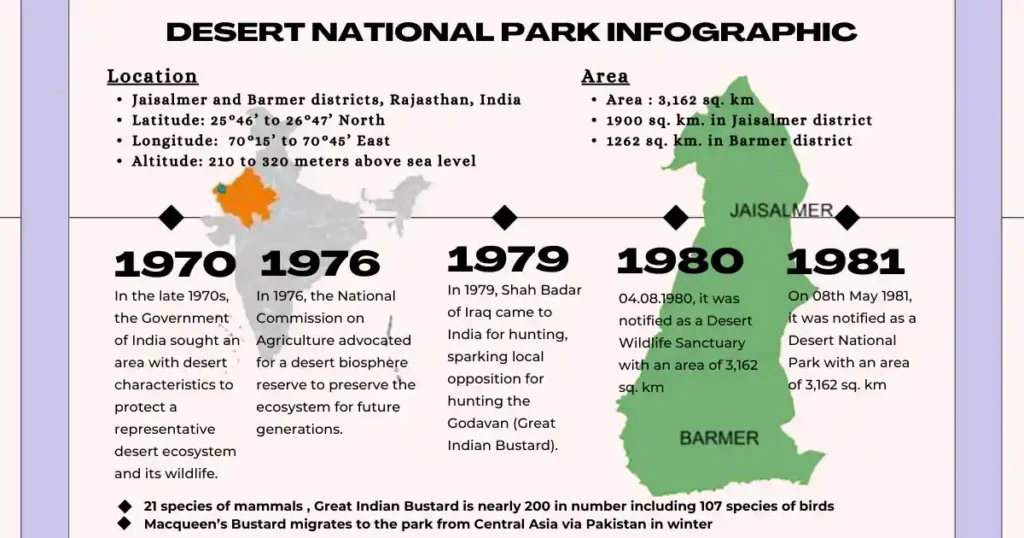


3 thoughts on “Desert National Park”